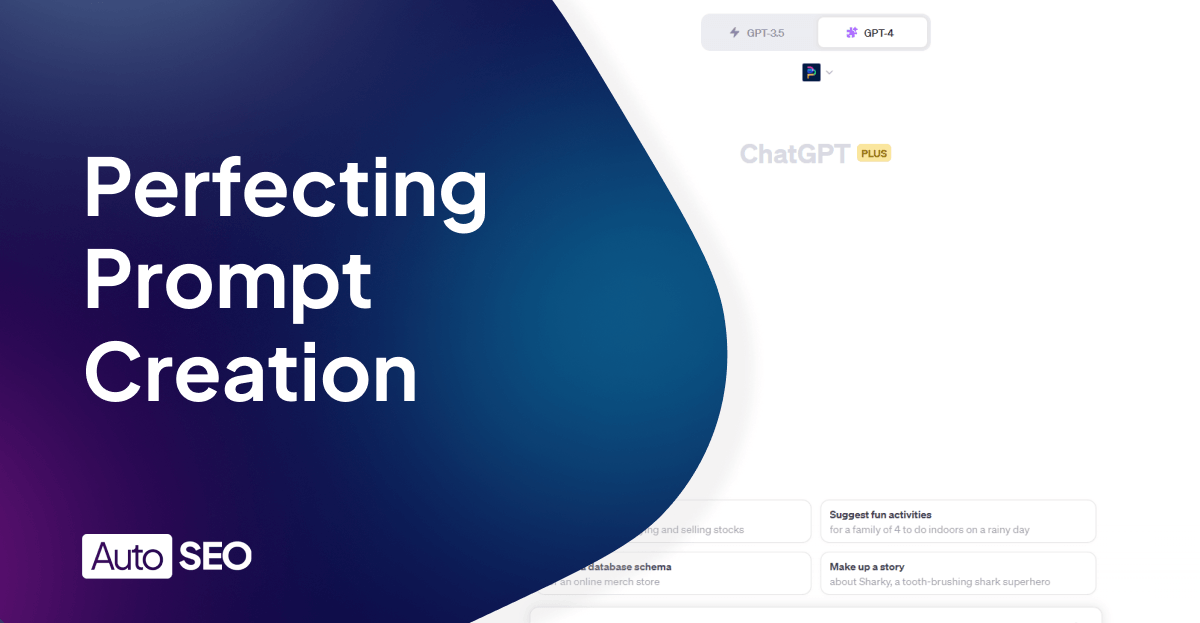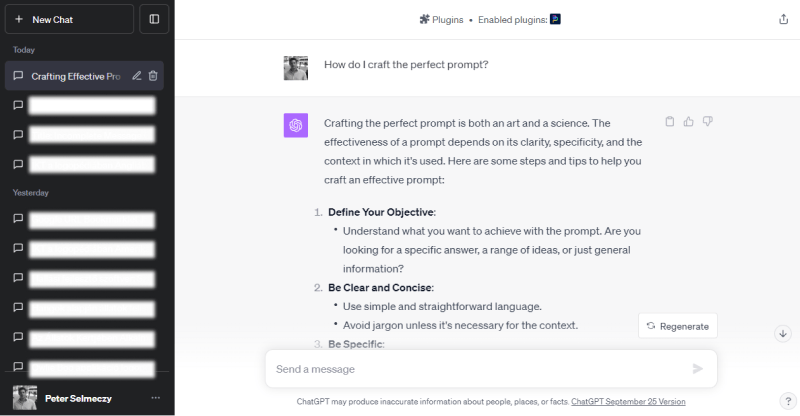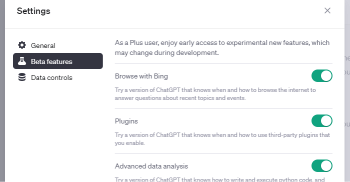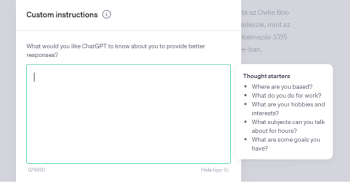ChatGPT Prompt for Content Creation

In the vast universe of AI, ChatGPT stands as a beacon for content creators.
But what makes it truly shine?
The prompt!
A well-crafted prompt for content creation can be the difference between a generic blog post and a masterpiece.
As we delve into the intricacies of ChatGPT and the art of prompt crafting, you’ll discover the nuances that can elevate your social media posts, video scripts, and overall content creation strategy, ensuring that it resonates with your target audience
Understanding the Mechanics of ChatGPT
ChatGPT, operates on intricate algorithms that process user prompts to generate relevant outputs. But here’s the catch: the quality of the output is directly proportional to the quality of the prompt.
The power of ChatGPT lies in the prompt. Master the art of crafting the perfect prompt, and you unlock a world of content creation possibilities, from blog titles to Instagram posts.
How ChatGPT Processes Prompts
Think of ChatGPT as a seasoned librarian. Give it a vague request, and you’ll get a broad range of books. But provide a precise query, and voilà, you have the exact book you were looking for. The AI processes prompts by analyzing the input, understanding the context, and then searching its vast knowledge base to produce a relevant response.
It’s a delicate balance of precision and creativity, ensuring that the output aligns with the user’s intent while also adding a touch of uniqueness.
The Role of Prompts in Determining Output Quality
A prompt is more than just a question; it’s a direction. It tells ChatGPT the path you want to tread, ensuring the content aligns with your vision. The beauty of ChatGPT lies in its adaptability.
Feed it a well-crafted prompt, and it can produce content that’s insightful, engaging, and tailored to your needs.
On the flip side, a vague or poorly constructed prompt can lead to generic or off-mark content.
The Art of Crafting a Prompt
Crafting the perfect prompt is akin to brewing the perfect cup of coffee. It requires precision, understanding, and a touch of creativity.
Just as the right blend of beans, water temperature, and brewing time can produce a sublime cup of joe, the right mix of clarity, specificity, and context can yield a ChatGPT response that’s nothing short of perfection.

Starting with Clear Objectives
Before you even type out your prompt, ask yourself, “What’s my end goal?” This clarity will be your North Star as you craft your prompt.
Whether you’re aiming for a detailed article, a witty tweet, or an insightful analysis, having a clear objective ensures that your prompt is aligned with your desired outcome. It’s like setting a destination on your GPS; once you know where you’re headed, the journey becomes much smoother.
Balancing Specificity and Flexibility
While being specific can yield precise results, allowing some flexibility can lead to creative surprises. It’s all about finding that sweet spot. Too specific, and you might box ChatGPT into a corner, limiting its creative potential. Too vague, and you risk getting a response that’s off the mark. The key is to provide enough direction for ChatGPT to understand your intent while leaving some room for it to flex its creative muscles.
Incorporating Context and Constraints
Context is king. By setting the scene or adding constraints, you guide ChatGPT to produce content that’s in line with your vision. For instance, if you’re looking for a historical analysis, mentioning the specific era or event can steer ChatGPT in the right direction. Similarly, setting word limits or specifying a particular tone can shape the output to fit your needs. The constraints define the boundaries, but within those boundaries, magic can happen.
Common Mistakes and How to Avoid Them
Ah, the pitfalls of prompt crafting. Even seasoned pros can stumble. But fear not, for we’ve got the antidotes to these common mistakes.
Being Too Vague or Too Specific
Remember Goldilocks and her quest for what’s “just right”? Crafting prompts is a similar endeavor. A prompt that’s too broad might lead ChatGPT down a myriad of paths, resulting in content that’s generic or off-target. Conversely, an overly specific prompt can stifle the AI’s creative potential, producing content that feels robotic or constrained. The trick is to strike a balance. Provide enough detail to guide ChatGPT, but leave some room for it to explore and innovate.
Overloading the Prompt with Information
While ChatGPT boasts an impressive ability to process information, bombarding it with excessive details can be counterproductive. It’s akin to giving a chef a list of 50 ingredients and expecting a simple, flavorful dish. The result might be overwhelming and lack coherence. Instead, focus on the essentials. Determine what information is crucial for the desired output and craft your prompt around those key points.
Ignoring the Iterative Nature of Prompt Design
Crafting the perfect prompt is rarely a one-shot endeavor. It’s an iterative process, much like sculpting. You start with a rough idea, shape it, refine it, and occasionally take a step back to make larger adjustments. Initial missteps are part of the learning curve. Embrace them, learn from them, and use them as stepping stones towards crafting that impeccable prompt.
Advanced Techniques for Prompt Optimization
Ready to level up? Dive into these advanced techniques to truly harness the might of ChatGPT.
Advanced prompt crafting techniques involve using system messages, experimenting with structures, and continuously adapting based on feedback.
Using System Messages and Instructions
System messages and instructions are like cheat codes in the world of ChatGPT. They offer an added layer of direction, ensuring that the AI not only understands the core of your prompt but also the nuances and subtleties you wish to convey. For instance, specifying a tone or style can guide ChatGPT to produce content that resonates more closely with your audience.


Experimenting with Different Prompt Structures
Variety, as they say, is the spice of life. Don’t be shackled by conventional prompt structures. Experiment. Play around with different formats, question styles, or even rhetorical devices. Sometimes, a simple tweak in the way you frame your prompt can lead to vastly different and potentially more engaging outputs.
- Ask it to behave as someone else
- Asking it evaluate it’s own quality of work
- Ask it to use programming logic
- The possibilities are endless
Adapting Prompts Based on Feedback Loops
In the digital age, feedback is gold. Whether it’s from user interactions, analytics, or personal reflections, feedback provides invaluable insights into the effectiveness of your prompts. Use this feedback to refine and adapt your prompts, ensuring they remain aligned with your evolving objectives and audience preferences.
Real-world Examples and Case Studies
Theoretical knowledge is a solid foundation, but real-world examples bring concepts to life. They offer tangible insights, showcase successes, and sometimes, more importantly, highlight missteps and the lessons derived from them.
Creating Blog Content
Your first ever prompt was probably something along the lines of:
Write me an article on {topic}As you learn more and more about ChatGPT it will likely approach something similar to what we here at AutoSEO use today.
- Custom Instructions enabled with our writing styles defined within the respondant section. Of course, our writing style is more than “formal with a mix of funny”. It goes into a lot of depth detailing everything from sentence lengths to variety to momentum and so.
- Plugins and Bing enabled to be able to connect to the internet
- Using a more advanced step by step prompt like below
Hi ChatGPT, you are now ContentGPT specialized in creating interesting SEO optimized content that pleases Google and website visitors alike. You will consider factors such as keyword use, natural language processing, and readability. I will provide you with the main keyword as the starting point as well as the goal of the article. The final article should be a minimum of 1500 words long.
I have provided you with a number of steps below, I will say "Next Step Please" when I'm happy with the given section and we can move to the next one.
After every step I'd like you to render the full content up to that point.
Step 1.
I would like you to create the title for the article. The title needs to be a maximum of 60 characters long. It needs to be enticing, use emotive language, and use the main keyword or a close variation of it. Please create 3 variations for me to choose from.
This will be the H1 of the article.
Step 2.
I would like you to create a meta description for the article. The meta description needs to be between 70 and 155 characters long , have a hook and contain the main keyword or a close variation of it. Please create 3 variations for me to choose from.
Step 3.
I would like you to create the article outline. Use a suitable structure that would guide a reader through the article. Use H2s and H3s with H4s as well if you consider it logical. For each heading give a 1 -2 sentence description of what you'd include under that section.
Step 4.
Write the content for each heading. Go through headings 1 by 1 asking me if I'm happy with the content before moving to the next heading.
Please ensure that you use the writing style that I have provided within my custom instructions.
Step 5.
Please find 5 different useful quotes and statistics to insert into the content.
Step 6.
I will give you a list of phrases that need to appear in the article
Thank you, do you have any questions before we begin, or are my instructions clear?
Creating a Plan for a Social Network
If you’ve ever tried to create a plan for social network postings (say LinkedIn) you probably first started with something resambling the below.
Create me a social calendar for LinkedIn posts.However you’re probably better of with something along the lines of.
I'm a SEO expert who posts daily on LinkedIn. You can find my previous posts here {insert link to a LI export}. Analyse these to get an idea of the tone of voice, frequency, and topics of my postings. Create a calendar of posts for Monday through Friday. I'd like each day to have a specific theme and my posts to flow clearly throughout the weeks and to build upon each other. The above two examples should give you a clear example of how you can go about building and expanding prompts in order to be able to achieve your aims and needs faster and better.
Buying Custom Prompts
If you’d like to get great prompts faster, there exists a range of libraries that will sell these to you. Some examples of these are:
Having personally bought a few prompts I do believe that they can help give you inspiration for creating better promts, and can be a good one-off solution. However, if you’d like to keep crafting better prompts going into the future then learning and experimentation will be your best bet.
The Future of Prompt Design
In the ever-evolving landscape of AI, staying static is not an option. As ChatGPT and similar models advance, the strategies and techniques for crafting prompts will also undergo transformations. Today’s best practices might be tomorrow’s outdated methods. Staying abreast of these changes, anticipating trends, and being adaptable are the keys to future-proofing your content creation strategy with ChatGPT.
The world of AI is ever-evolving. Stay updated, be adaptable, and always be ready to embrace the future of prompt design.
The Power of AI in Content Creation: By the Numbers
The rise of AI in content creation is undeniable, and the numbers speak for themselves:
- Market Growth: The market for AI in marketing is projected to reach $107.5 billion by 2028, a significant rise from $15.84 billion in 2021.
- AI Usage in Marketing: 33% of marketers who use AI employ it to generate ideas or inspiration for marketing content.
- AI Content Popularity: Since February 2022, web searches related to AI content have increased by 900%.
- Business Leaders Using AI: Half of business leaders are now using AI for content.
- Students Using ChatGPT: Nearly a third of college students admit to using ChatGPT to complete written assignments.
- AI in Book Writing: 23% of US book authors are using AI, with 47% using it to maintain good grammar and 29% to generate plot ideas and characters.
- AI in Newsrooms: Only 8% of newsroom executives see AI being used for content creation and quality improvement.
Conclusion
The journey of mastering ChatGPT prompts is a blend of art and science. It’s about understanding the mechanics, embracing creativity, learning from mistakes, and continuously striving for excellence. With the insights and techniques shared in this guide, you’re not just equipped to craft effective prompts; you’re poised to lead the charge in the next wave of AI-driven content creation.

Written by Peter Selmeczy
As the Head of Growth at AutoSEO I love everything about content, SEO, and AI. Hope you like my musings and would love to talk to you in the comments.



